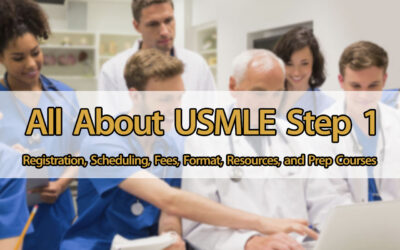The United States Medical Licensing Examination (USMLE) Step 1 is a crucial milestone in the journey of every medical student. The exam tests the knowledge accumulated over the first two years of medical school and gauges the student’s ability to apply these concepts in real-world clinical scenarios. So, how many questions are on the USMLE Step 1, and how does the examination structure impact your preparation strategy? This comprehensive guide delves into the specifics of USMLE Step 1, particularly emphasizing the number and format of the questions.
Overview of USMLE Step 1
The USMLE Step 1 is a one-day exam administered at the end of the second year of medical school. It assesses your understanding and ability to apply crucial core concepts of the sciences learned in the first two years. The test covers various subjects, including Anatomy, Physiology, Biochemistry, Pharmacology, Pathology, Microbiology, Behavioral sciences, and various interdisciplinary topics like nutrition, genetics, aging, and ethics.
How Many Questions Are on USMLE Step 1?
The USMLE Step 1 comprises up to 280 multiple-choice test questions. The questions are divided into seven 60-minute blocks, making it an 8-hour examination day. Each block can have a maximum of 40 questions, contributing to the total tally of 280. Given this structure, you can spend one to two minutes balancing speed and accuracy per question.
The number of questions and the time allotted per block imply that you need to master not just the content but also the test-taking strategy. Your ability to quickly read, understand, and answer each question within the stipulated time could significantly impact your overall performance.
Format of Questions in Step 1
Step 1 employs several different test question formats, each designed to assess a unique aspect of your medical knowledge and application abilities. The two primary types are:
- Single One Best Answer: The traditional format where there is a question and only one correct answer to choose.
- Sequential Item Sets: These are multiple questions following a patient vignette, giving you a narrative and requiring you to answer several linked questions.
Besides these formats, the exam questions often ask you to analyze graphical and tabular content, recognize both normal and pathologically affected samples at macroscopic and microscopic levels, and use your fundamental scientific understanding to address clinical issues.
How to Navigate USMLE Step 1 Questions
Navigating the questions on the USMLE Step 1 requires a clear understanding of the content and a well-developed strategy. Managing your time effectively, eliminating incorrect answers, and making educated guesses when unsure can significantly improve your score.
For instance, while approaching Sequential Item Sets, try to formulate an answer before looking at the available options. This strategy can help prevent the answer choices from misleading you.
Step 1 Test Prep: Navigating the QBanks
A common consensus among medical students is that question banks (Qbanks) are crucial to achieving Step 1. They provide an abundance of practice questions that mirror the actual exam, helping you get familiar with the style of questions and topics you’re likely to Qbanks offers a few distinct advantages:
- They allow you to apply the medical knowledge you’ve gained in a test-like environment, improving your recall and understanding.
- They provide immediate feedback, helping you identify areas of weakness to focus on during your studies.
- By simulating the time constraints of the actual test, they help improve your pacing and time management skills.
There are several Qbanks available, each with its pros and cons. The choice of Qbank largely depends on your specific needs, learning style, and the areas you want to focus on.
Final Thoughts: Conclusion
In conclusion, the USMLE Step 1 is a comprehensive test requiring knowledge, understanding, and strategy. With up to 280 questions spread across seven blocks, managing your time and optimizing your answering strategy are just as important as knowing the content. So, as you prepare for this crucial step in your medical career, remember to focus on understanding the concepts, practising with QBanks, and developing effective test-taking strategies.
Frequently Asked Questions (FAQs)
”How
The USMLE Step 1 exam comprises up to 280 multiple-choice questions divided into seven 60-minute blocks.
”What
The USMLE Step 1 exam is a computer-based test administered in a single 8-hour testing session. The questions are divided into seven 60-minute blocks, each containing up to 40 multiple-choice questions.
”What
The USMLE Step 1 utilizes a variety of question formats, including single best-answer questions and sequential item sets based on patient vignettes. The questions require you to apply basic science knowledge to clinical scenarios.
”How
Considering the 280 questions and the 7 hours allocated for the test blocks, you have approximately 1.5 minutes per question. However, as the number of questions per block can vary, some may need more time to afford.
”What
The USMLE Step 1 questions cover various medical subjects, including Anatomy, Physiology, Biochemistry, Pharmacology, Pathology, Microbiology, Behavioral sciences, and various interdisciplinary topics like nutrition, genetics, aging, ethics, etc.
”How
As of January 26, 2022, the USMLE Step 1 exam is scored as pass/fail. Previously, scores were numeric, with a minimum passing score of 196.
”Can
Yes, within each 60-minute block, you can review and change your answers. However, once you end a block or the block time expires, you cannot return to that block.
”What
The questions in USMLE Step 1 are crafted to evaluate your comprehension and capacity to utilize fundamental scientific principles in the context of medicine. The primary focus is on the principles and mechanisms that underpin health, disease, and various therapeutic approaches.
”Are
Yes, you have a 45-minute break time during the 8-hour test session. The test day also includes an optional 15-minute tutorial at the beginning. If you skip the tutorial, you can add this time to your break time.
”Where
The USMLE Step 1 is administered at Prometric test centres, available in various locations in the United States and internationally.
”When
Step 1 results are released every Wednesday. The score reporting time can range from two to eight weeks, but you will likely receive your results within two to four weeks.
”How
As of January 26, 2022, USMLE Step 1 is pass/fail. This means you won’t be given a specific score, nor will residency programs. The minimum score to pass Step 1 is 196.
”Can
Yes, you can retake Step 1 thrice within 12 months. However, a fourth attempt must be at least 12 months after your first attempt and six months after your most recent attempt.
”What
Failing Step 1 is a setback, but it’s not the end of the world. You can retake the test. First, however, it’s crucial to reassess your preparation strategy, identify your weaknesses, and develop a solid plan for your next attempt. Remember, persistence and a well-directed effort often lead to success.
”How
As of the last update, for students and graduates of medical schools located in the United States and Canada accredited by the LCME or AOA, Step 1 costs $975 plus a $180 surcharge for writing outside the US.




